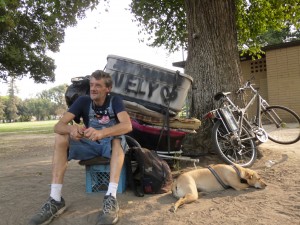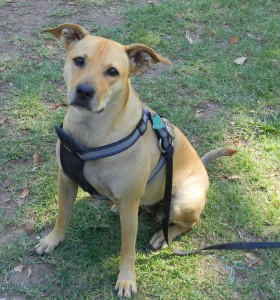
With its high poverty and unemployment rates, the San Joaquin Valley has a larger homeless population than the nation as a whole. Even so, most homeless people aren’t outside longer than a few months. The exceptions can include those who routinely use shelters, work at least part time, and have small incomes.
The canners are atypical. In her study of homeless recyclers in San Francisco, Teresa Gowan found them independent, proud, hard-working, and resourceful. While many used drugs, they didn’t fit the typical addict profile and resented being lumped in with criminals, addicts, panhandlers, drifters, the mentally ill, and others of the homeless population.
Survival
After Carl and his canner friends Frank and Louise established themselves in their central Modesto location, they soon found they could maximize their earnings by following established routes that produced a consistent bounty of bottles and cans.
Carl, who calls himself a “survivor and a survivalist,” immediately began using some of the money he earned to acquire a survival kit. He also worked on the psychological strengths needed to survive daily existence in the urban outdoors.
“You’re always alert and you’re always around crazy people,” he says, after ten years on the street.
In Carl’s small universe, not all crazy people are homeless. After a heated argument with a young homeless man not associated with “the family,” one nearby resident decided to send a message by having a small posse of large men stage a sneak attack on homeless people in the park. Carl and some others were roughed up—hit and kicked—but the attack didn’t last long and no one was severely injured.
“We weren’t even the ones she was mad at,” says Carl, who has never accepted the multiple injustices that follow from the assumption that all homeless are alike.
In addition to developing a survivor’s attitude, Carl assembled a tool kit. He knew he couldn’t afford down time for his bicycle, so he obtained a pump, a crescent wrench, pliers, screwdrivers, channel locks, and a short-handled hammer with a large head.
It’s a rare day when no one shows up needing Carl’s skills as a bike repairman. His friend Frank Haynes, a self-employed man who lives indoors says, “Carl is the best bike repairman in Modesto; I’ll wait two hours for Carl to fix my bike because he does it right.”
People using Carl’s services pay or don’t pay, depending on their wherewithal and inclination. Sometimes payment is in the form of food or found objects. When asked why he’s so generous with his time and tools, Carl replies, “I’ve always wanted to help. I just like to help people any way I can.”
Anyone who recycles for daily cash soon learns that trying to balance large sacks of bottles and cans while riding a bicycle is dangerous. Besides a good bike, almost all the serious recyclers have a least one sturdy trailer and many have “trains” that feature multiple containers for their possessions and daily haul.
After a few good paydays from odd jobs offered by homeowners who learned about his reliability and handyman skills, Carl bought a battery-powered eZip bike. Driven by a 24 volt battery, the bike enables Carl and friends to load up and move out when there’s a heavy trove of recyclables from a major event like a concert or large family gathering.
For cooking and heat Carl favors a propane torch. It’s faster and cleaner than a stove and enables him to apply heat quickly to a variety of items.
After a few winters outside, Carl learned some hard lessons about clothing. “You’ve got to be weather-wise,” he says. “You’ve always got to have dry clothing ready to put on. If you get wet and cold out here, it’s easy to catch pneumonia, and even easier to die from it.”
To those who say homelessness is like camping out, Carl replies, “Tell ‘em to try to live out here when it’s 31 degrees and below.” After a particularly cold winter, he bought a refrigerator suit of the kind used by meat packers and others who spend time in low temperature environments.
“Little’s”

While he had always refrained from owning a dog because of the heavy responsibility, in 2009 he couldn’t resist a pup he named “Little’s” because she was the daughter of a friend’s dog called “Chicken Little.” A mix of Chow Pei, Cleveland Heeler, and Australian Sheep dog, Carl claims she can bring his fully loaded trailer from a standing start to cruising speed in a few seconds.
“She’s my guard dog, my heater, and my best friend,” he says fondly.
Little’s is as independent as Carl and his canner friends. When she and Carl go for a walk, she grabs her leash in her mouth and takes the lead. “She won’t let me walk her,” says Carl. “She walks herself.”
Trouble and Beyond
Recently, after a Modesto Bee news story about homeless people in the parks, the police showed up and began questioning some homeless people and searching the belongings of others. Sometimes the police officers were egged on by homeowners who frequent the neighborhood. There was a lot of agitated barking among the various dogs, and some shouting.
At one point someone pointed to the homeless man nicknamed “Rewind” and insisted the police investigate “that drunk.” Highly agitated, Carl began shouting, “He doesn’t drink, he doesn’t drink.”
Despite Carl’s protests, a police officer woke the befuddled man, who had been sleeping on the lawn, face up. It soon became apparent that Rewind was neither drunk nor capable of harm.
Carl remained upset long after the incident. “Can’t they see he don’t harm anyone?” he said. “These people got nothing better to do than harass a helpless old man. They got nothing better to do than that. They’re mean and they’re evil.”
It may be that when Carl sees someone harassing helpless creatures like Rewind he sees also a small boy for whom no one was there when he needed help, and the agony returns. “No child should have to grow up like I did,” he sometimes says.
On good days, when the park is quiet and absent strangers and potential troublemakers, Carl will grab a tennis ball and wave it aloft. Little’s then jumps to her feet and off they go to an expanse of grass long enough for a good run and fetch. On the way, Carl chatters and waves the ball around while Little’s jumps and pivots. During these brief interludes, it can seem the two friends have, almost, found shelter in their joy.
